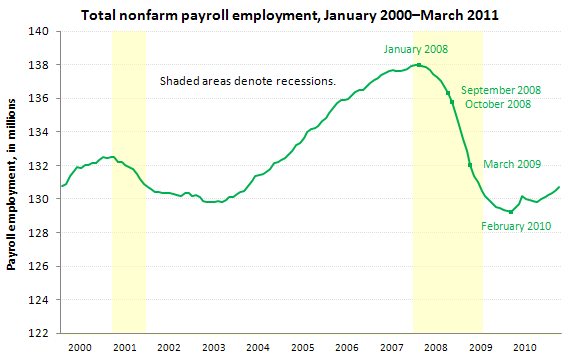May 04, 2011 (The Editor’s Desk is updated each business day.)
Employment during the 2007–2009 recession
The U.S. economy officially entered a recession in December 2007. Nonfarm employment peaked in January 2008 and then entered a period of steady decline.

[Chart data]
During the first 9 months of the recession, nonfarm employment decreased by 1.2 percent, a change that fell in line with the relatively modest losses of the 1990–1991 and 2001 recessions. In addition, the distribution of job losses by industry during the early stages of the most recent recession was similar to that during the two previous recessions. During the first half of the 2007–2009 recession and the entirety of each of the previous two recessions, a little more than half of job losses occurred in manufacturing and construction (which both tend to be sensitive to the business cycle).
The shallow employment declines did not last, however. The economic downturn intensified in September 2008 when the economy was jolted by trouble in the Nation's financial system. In the aftermath of the turmoil, credit markets constricted and banks tightened lending standards. The recession rapidly deepened, and job losses spiked.
Monthly job losses averaged 712,000 from October 2008 through March 2009—the most severe 6-month period of job losses since 1945, when WWII was ending. During the final 3 months of the recession, April through June 2009, job losses remained severe but moderated somewhat to an average monthly employment decline of 516,000. Despite the official end of the recession, nonfarm employment declined by another 1.2 million until reaching a trough in February 2010.
These data are from the Current Employment Statistics program. To learn more, see "Employment loss and the 2007–09 recession: an overview" (PDF), by Christopher J. Goodman and Steven M. Mance in the April 2011 issue of the Monthly Labor Review.
Related TED articles
Employment |
Metropolitan areas and counties
Of interest
Spotlight on Statistics: National Hispanic Heritage Month
In this Spotlight, we take a look at the Hispanic labor force—including labor force participation, employment and unemployment, educational attainment, geographic location, country of birth, earnings, consumer expenditures, time use, workplace injuries, and employment projections.
.
Read more »
